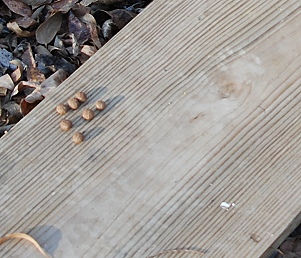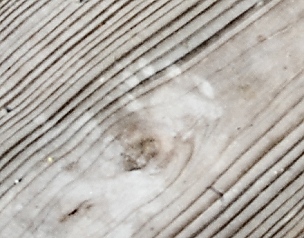Observing wildlife–and the sign they leave behind–is one of the satisfactions of having some land. It’s also a necessary part of our wildlife management program. Census is one of the seven essential activities under the Texas Parks & Wildlife private lands wildlife program.
This makes sense–if you don’t know what you have, or (roughly) how many of it, you can’t manage it very well.
Cameras help with observation even when the animal isn’t there: photographing tracks, scat, nests, etc., can document the presence of something you don’t often (or ever!) see. So can simple interventions. We discovered that animals regularly used the paths we mowed for ourselves and the planks we put across muddy dips for our own convenience. In wet weather, they left footprints; they often left scat. One great horned owl neatly dropped two regurgitated owl pellets onto one plank.
Here’s an example of a “plank find”:

Plank with scat and tracks
The scat is obviously cottontail pellets–right size. If we needed an exactc size, the plank is still there, and the wood grain could be measured even if the pellets had blown off the plank nex ttime (the full picture shows specific knots that would locate the pellets.) There was another pile of them a few feet away on the same plank.
The tracks, however, aren’t rabbit tracks. Five-toed–so no kind of cat or dog. Not possum or raccoon, either, by the shape and angle of the toes. From the other smudges, the animal was up on the board, moving about near the rabbit scat–perhaps sniffing it? The smudges are pale–not really mud, perhaps dust on the animal on a morning when the board itself was wet with condensation–the last three mornings have been foggy. In fact, I did not notice the pale smudges when taking the picture–I was photographing the scat.
I have a book of animal tracks, and from that had narrowed it down to two animals I know we have, ringtail cat (Bassariscus astutus, photographed on the place a few years ago) or skunk (often seen, and smelled, but never photographed) whose paws are in the right size range. Because it wasn’t wet enough for the animal to pick up mud on its claws, and leave obvious claw marks (just pad marks) I used enhancements in my photo-processing software to bring out the print more clearly:

I could now see for sure that what I thought I’d see in the pale form–pale dots in front of two toes–did in fact belong to the print…and the distance of the dots from the toes indicated ringtail cat, not skunk (skunk claws are longer, and the tips touch a surface farther away from the toes, according to my book.
Without the camera–and the computer–I would not have been able to document this–I might have thought the vague smudges on the board were just the rabbit.
Comment by AnnMCN — December 21, 2008 @ 4:50 pm
I just read all the entries, and this is fascinating. What you are doing in enhancing the photos is bringing out hidden information, but not altering or adding to it.
And thanks for the RSS feed!
Comment by elizabeth — December 21, 2008 @ 10:56 pm
Glad you’re enjoying it. And my webguru gets the credit for the RSS feed–I had no idea how to do it.